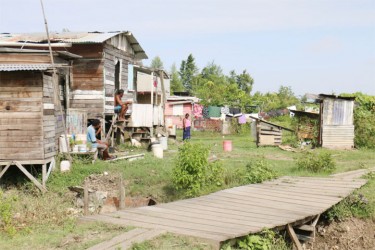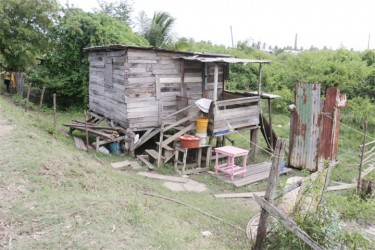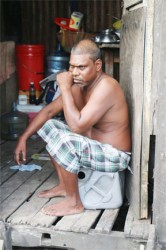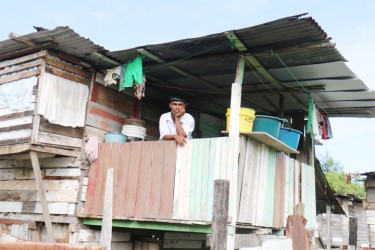Story by Jeanna Pearson with photos by Arian Browne
Approximately eight miles from Georgetown poverty-stricken Indian families are crammed into small dilapidated shacks along a dam near the banks of the Chateau Margot seawall. Hidden away behind Pigeon Island, this dam is home to over 200 squatters, many of them children.
As the decades passed, the number of old zinc shacks increased in the Pigeon Island squatting area along
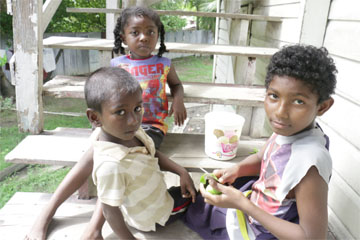
with a distant cry for potable water and better living conditions. Sometimes six to eight persons live in one rickety structure.
And even though a standpipe was installed to provide potable water for the squatters two years ago, some families still have to buy water in order to bathe, wash and cook. Children are exposed to germs and viruses that linger around their houses and live in the faeces contaminated drains, which leak through latrines.
The muddy dam on which the houses sit is squashed between two trenches. One trench faces the ocean and usually goes dry when the tide is low while the other one leads to the Pigeon Island Pump Road. This road is the squatters’ only access to the dam since a bridge nearby was broken down after years of neglect and decay. Squatters said that the bridge, which was once their exit out of the area, was destroyed by a resident of Pigeon Island, who refused to let them cross into his yard to get to the main road.
“We didn’t chose to live here; it chose us,” Kalowttie Bagwandatt, an old woman said.
After Bagwandatt’s family declined into poverty, she said, her husband brought her to the dam and built a zinc house for her. That became their home for over twenty years and the place where they raised three sons.
“It ain’t proper living here but we gah make do with what we have,” she said. We don’t wanna stay in this place…we want our own land where we can build a house and live good.”
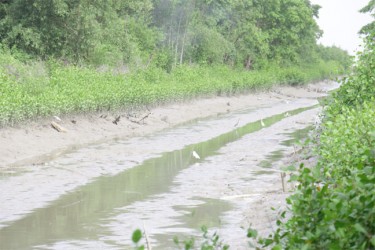
Bagwandatt said that there were five houses when she first moved to Pigeon Island. It was mostly young families with children, plenty children, she said. And life became harder, she related, as the years passed, especially after her husband died and left her to raise their three boys.
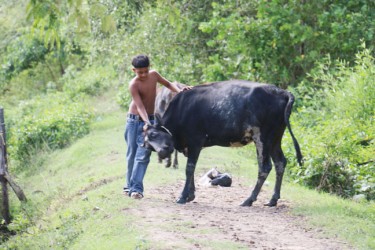
“After all that I got stroke and my sons had to take care of me.” Every afternoon she would sit on a bench outside their home and wait for them to return from work. Two mattress take over most of the space in Bagwandatt’s house.
Her nephew, Kemraj Bagwandatt, lives next door with his sister in an old wooden house. He said that he has been living on the dam for ten years and his experience was bad. He described living in the area as “rough” and “nasty.”
“The experience rough; me glad if I can get house lot to move ahead cause me ain’t want to stay in this condition. When the rain fall the dam would be muddy and them children have to walk through the mud, plus two three families have to use one latrine,” he said, adding that some people who didn’t have a bathroom would bathe on their steps or in their yards.
However, he said that there was no other place to go. “We gah live yah even though we struggle every day,” he told this newspaper, adding that he felt that people in Pigeon Island squatting area were neglected and being denied a chance for proper housing. “It’s not like we choose here; we didn’t have a choice. We gah survive. Children have to go school.”
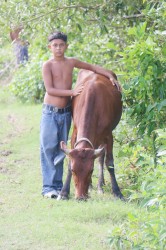
“When the rain fall the place is get nuff mud and they children is get germs because the place ain’t clean…see, we ga struggle all the time.”
Bagwandatt said that his day starts at 3 am every morning. He would get up, light his lamp and hang it outside near his fireside and prepare the meal for that day. He is a sugar factory worker at Enmore. “We gah live here so we ga make the best.”
Some other families mind animals in order to make a living, and cows can be seen wandering around the area.
The Bagwandatts are not the only family that is crying out for house lots. “We glad if we can get house lots and move from here because we have little children and they is catch germs because of the condition of the place…” Vamir Bacchus told Stabroek News.
Bacchus has been living on the dam for over twenty years with his wife, three children and mother-in-law. He said that before the pipe was installed, children used to have to fetch water from other villages, paying by the bucket. He said that he was thankful that they didn’t have to pay money for water to bathe and wash their clothes any longer. “Now people take it by turn at the pipe…they would hurry to get lil water in the morning to send their children to school or go work,” he said. “We ain’t got to use the trench water no more to wash our clothes and bathe.”

He said that the squatting area was not a quiet place since most families would drink a lot of alcohol and pick fights with their neighbours. “Most people ah drink rum and fight in this area. It ain’t a good place to live.”
“Me ain’t like nothing about this place. People think that we don’t want to come out from here, but we want to because this ain’t a place to like,” he said. Most people, he said, continue to live on the dam because they don’t have anywhere else to go or they are waiting on land from the government.

He said that people were unaware that Pigeon Island had a squatting area because it was hidden behind the village. “People would pass and not see we at the back here, living in this condition.”
“We can’t continue to live here. We have to seek betterment because we too have children to mind and fetch to school to get an education,” Shaheed Mohammed said. He has been living in Pigeon Island squatting area for 15 years. He lives in a small zinc house, dominated by a single mattress, with his wife, four children and grandchildren. He said that he had applied for house lots a few years ago and was waiting for the day when he would get a piece of land to build his house.
